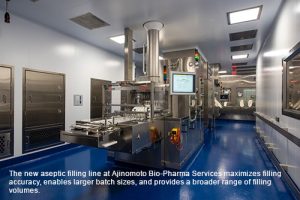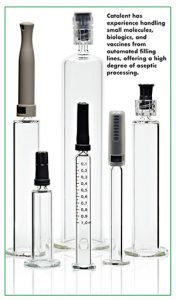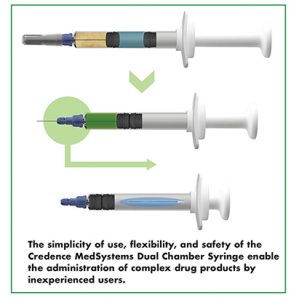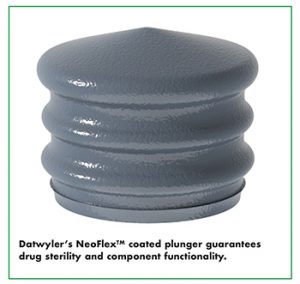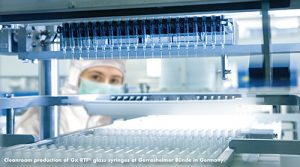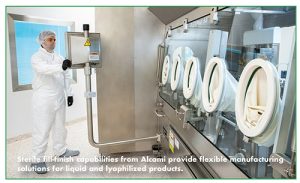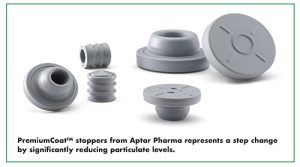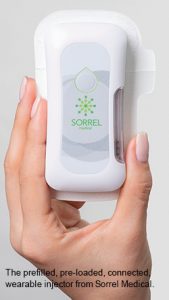Issue:May 2020
SPECIAL FEATURE - Prefilled Syringes & Parenteral Manufacturing: Innovations, Challenges & Solutions
The global injectable drug delivery market was valued at $331 billion in 2015 and is expected to reach $931 billion by 2024.1 The market is segmented by product: pen injectors, autoinjectors, wearable injectors, and needle-free injectors. An increase in home self-administration and the projected growth for biologics therapies to treat these chronic conditions are driving these sectors. While large molecule biologics dominate the market, the demand for small molecule parenteral products is also increasing.2 According to Transparency Market Research, the global small molecule injectable drugs market will expand substantially from 2017 to 2025 due to growth in generic injectables, which is outpacing that of innovator drugs, a strong pipeline of small molecule injectable drugs, and significant investment in R&D for small molecules.2
Additionally, the global Prefilled Syringes Market (PFS) market is projected to reach $9.53 billion by 20263 because of their ease at delivering injectable drugs to treat chronic diseases.4 PFS materials include glass and plastic. Glass has strong barrier properties, which make it the preferred material for the manufacturing of prefilled syringes. Additionally, glass is highly compatible with different filling drug machines. However, certain concerns over breakage and the reaction of glass ions with the drugs could shift the preference from glass prefilled syringes to plastic prefilled syringes. The plastic segment is anticipated to be the fastest-growing segment owing to technological innovations.5
This annual Drug Development & Delivery report features several leading companies’ innovations in delivery devices as well as how contract parenteral manufacturers are addressing the ever-demanding challenges, issues, and opportunities related to delivering biologics and small molecules.
Ajinomoto Bio-Pharma Services: Manufacturing Complex Formulations
As no two manufacturing processes are identical, the Ajinomoto Bio-Pharma Services drug product manufacturing team works with a range of processes, from a simple formulation, filtration, and fill to high-potent complex formulations, which can take place over several days and require non-standard filling operations, explains Megan Owen, Senior Manager, Drug Product Manufacturing, Ajinomoto Bio-Pharma Services.
“We offer scheduling and component flexibility with four automated vial filling lines and an automated prefilled syringe filling lines. Additionally, we offer hundreds of qualified container closure configurations, ensuring that we have a configuration that is compatible for each of our clients’ product requirements.”
She says the company also looks to industry trends as decisions are made regarding investing in new technologies and capabilities. For example, as the market for highly potent APIs is steadily growing so is the need to safely manufacture and fill these highly potent products. “To that end, we have installed a dedicated, fully contained and integrated fill line at our San Diego location that not only mitigates the inherent risk of exposure but also efficiently handles a range of fill volumes,” she says.
Additionally, the CDMO has invested in a flexible fill line to support the aseptic fill of drug substance APIs. “This new line increases our capacity by 50% and enables us to process larger batch sizes and volume ranges for vials, syringes, and cartridges,” says Ms. Owen. “The new multi-purpose line also allows us to utilize Ready-to-Use (RTU) vials, cartridges, and syringes to reduce requirements for the manufacturing process.”
In 2019, Aji Bio-Pharma guided nine clients through their PPQ campaigns and established parameters for commercial production of their drug products. One of the campaigns was particularly challenging as it was a complex formulation of a viscous product. In addition to the formulation challenge, viscous products can be difficult to fill, while maintaining final dosage accuracy. Multiple departments across Aji Bio-Pharma (Drug Product, Quality Control, Quality Assurance, and Validation) collaborated with its client to produce a robust and repeatable process to support its commercial manufacturing campaign. This involved using specialized formulation equipment and custom fill tubing assembly coupled with engineering runs to optimize the filling parameters.
AMRI: Overcome Common PFS Challenges With a CDMO Partnership
The increase in biologic drugs presents particular obstacles, primarily attributed to viscosity. Different products have differing viscosity, or centipoise levels, requiring unique processing solutions. A major challenge is cleanly dispensing product into the syringes, as product will often stick to the tip of the filling needle and create a trail of product along the syringe after dispensing.
CDMOs must work with both clients and equipment manufacturers to overcome such challenges, necessitating product-centric solutions and high levels of expertise. For example, collaborative efforts with key equipment vendors were conducted at AMRI’s Albuquerque, NM, facility to engineer, reprogram, and test the Programmable Logic Controller (PLC) for the motion and timing of fill curves, allowing for better process parameter predictability of the equipment.
“Having completed media fills and scaled up commercial manufacture for two existing lines, AMRI can offer cGMP aseptic processing and enable pre-approval inspections for commercial products, transferring capabilities at speed to new commercial drug product manufacturing requirements,” says Anish Parikh, Vice President, Sales & Marketing – Drug Product, AMRI.
Handling controlled substances is another challenge intensified by viscosity. A robust reconciliation process is needed to track and trace batches to quantify the controlled substance deployed. At AMRI, compliance managers account for product usage levels from start to final packaging, including product quantity used in preparation and flushing of production lines. “Such robust processes are critical in assuring compliance and successfully clearing rigorous DEA auditing,” says Mr. Parikh.
AMRI also supports clients in product material selection. “We’ve seen an increasing demand for plastic over glass, but selection rests on more than the inherent properties of the base materials being filled,” he says. “Our analytical team expert in extractables and leachables, container testing, and heavy metal detection, significantly aids in optimizing container closure design for a given product and is a valuable resource for our clients.”
Baxter BioPharma Solutions: Automated Inspection Identifies Particulates
One of the largest challenges in parenteral manufacturing is preventing particulate matter from entering the product. While the particulate matter can be reduced with careful inspection, it is almost impossible to eliminate. Baxter BioPharma Solutions takes a two-pronged approach to this challenge. First, the R&D laboratory located onsite is fully equipped for isolating and identifying particulate matter. This aids in rapidly identifying the possible sources and in progressing with the batch. Next, a team was established that includes representatives from manufacturing and R&D that evaluate all possible sources for contamination. The evaluations pinpoint areas for improvement and reduction of particulate matter.
“All parenteral products must undergo 100% visual inspection to eliminate units that appear with defects or particulate matter,” says Gregory A. Sacha, PhD, Senior Research Scientist, Baxter BioPharma Solutions. “The goal is to utilize automated inspection machines because they are tremendously faster than manual inspection. This is challenging for syringes that are filled with dispersed systems used as vaccines because the dispersed material can appear as particles or can settle within the syringe and appear as a defect. Baxter BioPharma Solutions is well equipped with automated inspection equipment that is followed by automated container closure integrity testing.”
The automated inspection equipment is qualified using prefilled syringes from a defect library that are placed randomly within acceptable units. The goal is for no more than one defect to be accepted and to ensure that the number of false rejects does not exceed an established threshold percentage of the total defective units identified, he explains.
“It is advantageous for the Baxter BioPharma Solutions to have automated container closure inspection equipment attached to the inspection line,” advises Dr. Sacha. A particular challenge with syringes that are equipped with pre-staked needles is for the needle to protrude through the cap. The protrusion is often difficult to detect with the naked eye. Automated container closure inspection equipment aids the identification of defective syringes from multiple batches.
While syringes are available in glass and polymeric formats, terminal sterilization of polymeric syringes can be challenging, says Dr. Sacha. A recent client desired to use polymeric syringes and terminally sterilize its product. He explains that initial trials produced prefilled syringes with a haze that was not visually appealing. Baxter BioPharma Solutions developed a method to terminally sterilize the polymeric syringes while preventing development of the haze. This required adjusting the parameters to slowly cool the syringes post sterilization.
BD: Optimizing Administration for Multiple Stakeholders
There has been increased use of traceability of injection devices, in the manufacturing process, the supply chain, and even in terms of patient use. Though the basic technical foundations of these solutions are now relatively established, robust end-to-end solutions, integrated with existing industrial and clinical monitoring systems, are still not widely available on the market.
“We feel very strongly about this at BD, given our breadth of experience incorporating smart capabilities into devices and in the digital monitoring of drug delivery systems, as well as in the collection and analysis of healthcare data,” says Marie-Liesse Le Corfec, Head of Global Portfolio Marketing at BD Pharmaceutical Systems.
As market needs evolve, BD is shifting from providing products to providing full solutions that address the needs of the multiple stakeholders involved in the healthcare ecosystem. BD’s range of platforms span the vaccine, drug volume, and viscosity continuum.
“Our customers can start their development in our injection containers and devices with a broad design space that they can then narrow over time, as their drug development evolves, constraints emerge, and decisions are made about formulations, volumes, possible drug container compatibility issues, and ergonomics,” she explains. This can be achieved through commercialized platforms such as our range of prefillable glass or plastic syringes and stoppers for various usages (BD NeopakTM, BD SterifillTM Advance, BD HylokTM, BD HypakTM for Vaccine), BD Ultra-SafeTM passive needle guards, BD VystraTM disposable pens, BD PhysiojectTM, and BD Intevia autoinjectors, as well as products in development, such as BD LibertasTM wearable injectors and BD EvolveTM programmable on-body injectors.
BD also works with customers to recommend the best packaging solution for their applications. Typically, Ms. Le Corfec says for medication in volumes over 10mL, which are often infused through pumps, the recommendation is to use polymer prefillable syringes such as BD Sterifill Advance, which is designed to be automatically recognized by pump software, and benefit from a light weight and a high resistance to breakage.
She adds that for volumes under 5mL, glass remains the best-in-class material relative to inertness, permeability to O2, transparency, and resistance to scratches during the manufacturing process. And for volumes between 5 and 10mL, the optimal syringe material, either glass or plastic, depends on several criteria such as drug compatibility, syringe format, manual vs. power-driven delivery, emergency use, etc.
Catalent Biologics: High-Speed Filling Lines Get Products to Patients Faster
Companies are demanding more capacity as their products continue to go straight into syringe presentations rather than vials during clinical trials. The growth in syringe demand earlier on has necessitated that many manufacturing partners, such as Catalent Biologics, reconsider their internal capacity. Catalent has addressed this by undertaking a $100-million expansion to its drug product manufacturing facility in Bloomington, Indiana, which includes the addition of a new high-speed syringe filling line, due to be completed in 2021. Additionally, that same facility recently completed a $14-million packaging expansion, while the Brussels, Belgium, site completed a $13.5-million packaging expansion in 2018.
“With these packaging investments, our sites have expanded their safety device and autoinjector capabilities and capacities, brought about by an increase in demand as more commercial products move towards self-administration devices,” says Brian Galliher, Senior Process Engineer, Catalent.
He says the high-speed filling lines in Brussels and Bloomington can meet a combined annual capacity of up to 290 million syringes for biologics, small molecules, vaccines, and diluents. Across these two sites, other options include containment (barrier isolator or restricted access barrier system), different filling mechanisms (time pressure, peristaltic pump or rotary piston), and varying component sizes (ranging from 0.5mL to 20mL).
“Additionally, by having secondary packaging integrated within the two sites, including autoinjector and safety device assembly, Catalent Biologics can expedite the packaging process, allowing quality products to get to patients faster,” says Mr. Galliher.
In fact, a customer recently asked Catalent to help introduce a new product to market far quicker than is typical. “Due to our long-standing relationship with this customer and familiarity with each other’s needs, we were able to support its project from filling to device assembly and launch,” he explains. “An agreement was quickly reached that it was imperative to launch this product into the market rapidly. With a cross-functional, cross-company team, we were able to fill, assemble, and launch the customer’s product into market within just 30 days.”
Credence MedSystems: Enabling Broad Access to Dual-Chamber Fill-Finish Processing
Last October, Credence MedSystems was awarded a grant from the Bill & Melinda Gates Foundation to support the development of Credence’s Dual Chamber Reconstitution Syringe tailored for use in developing nations. The project will solve a major problem in the global health setting by allowing last-mile administration by untrained users of vaccines and contraceptives requiring reconstitution.
John A. Merhige, Chief Commercial Officer, Credence MedSystems, says macro market dynamics are driving growing demand for Credence’s Dual Chamber Reconstitution Syringe, resulting in numerous pharma collaborations and development advances. These dynamics include growth in the biologics and self-injection markets. “The fact that many of these injectables and particular biologics require storage in dry form introduces the added complexity of needing to reconstitute at the time of use,” he says. “These dynamics result in the need for an intuitive delivery system that promotes successful reconstitution and injection by less-experienced users.”
He asserts that the Credence Dual Chamber Syringe is unique in the industry due to its simplicity of use, its flexibility to use off-the-shelf syringes of varying sizes and materials, its ergonomic design and compact environmental footprint, and its safety features. To enable mixing, the user pushes on the plunger rod; after mixing, the user delivers the medication and receives end-of-dose tactile and audible cues, signaling that the full dose has been delivered. Upon completion of the injection, the needle automatically retracts into the syringe barrel, preventing accidental needlestick and reuse. Further, incorporating the dry form and the liquid diluent into the chambers of one primary package enhances the likelihood of appropriate reconstitution ratios and dosing, while minimizing environmental footprint and added supply chain complexity.
Credence is working on derivatives of its Dual Chamber System, encompassing glass and polymer barrels, as well as barrel sizes ranging from 1mL to 20mL. “The flexibility of the technology enables system customization,” he says. The Dual Chamber System can be used with a pre-attached needle or in a luer lock configuration for alternative routes of administration. Additionally, Credence is working with numerous large and small biopharma customers to advance the Dual Chamber System towards clinical use.
Broad access to dual-chamber fill-finish capabilities requires a supply chain that continues to advance and serve the expanding needs of patients. “Traditional limitations in the supply chain for dual-chamber fill-finish capabilities have hindered the ability to meet the pent-up and growing demand for this system,” says Mr. Merhige. “This has kept solutions that can help patients from the market. However, as that market need and potential have become more obvious, there has been significant progress. Credence is working actively with partners in the supply chain towards the goal of enabling broad access to dual-chamber fill-finish processing. This includes in situ lyophilization as well as offline lyophilization approaches.”
Datwyler: Plunger Designed with Functionality in Mind
While low break loose and gliding forces have been the main factors in determining PFS component design, the list of functional user requirements has become much longer and continues to grow with the introduction of new applications and therapies. For manual applications, a low break loose force makes it easier for the user to inject the drug. This requirement has resulted in plungers designed with very low compression, causing the risk for leakage has increased greatly. In addition, a low break loose force and a low compression also means that the plunger will move more easily during air transport. If the plunger moves too much, it might move into the non-sterile area of the barrel, which can increase the risk for drug contamination.
For automatic injections, the break loose force value is not as much of a concern as in manual applications because the device can be developed to cope with higher forces. The consistency over time is more important in automatic injections to guarantee good device performance throughout its life cycle.
Although there is no clear ISO guideline with regard to acceptable break loose forces, market research indicates that most customers prefer a break loose force below 10N, with 15N being an acceptable value, and 20N being the absolute maximum, explains Carina van Eester, Global Platform Leader, PFS and Cartridges, Datwyler. For gliding forces, the values are mostly dependent on drug viscosity, needle size, and the impact of the drug on the siliconization of the barrel.
“If we consider all of these requirements, some compromises have to be made to develop a PFS component that can guarantee drug sterility and component functionality for both manual and automatic injections,” she says. “The new NeoFlexTM-coated plunger from Datwyer was developed with all of these requirements in mind. The compression of the plunger, the shape of the rills, and the finishing of the trim edge were optimized to create a fully coated plunger that offers a high safety margin of sterility and a consistent break loose force over time.”
She adds that the NeoFlex plunger works in different siliconized barrels – from standard siliconized, to low siliconized, and cross-linked siliconized barrels. And, NeoFlex is suited for use in COP/COC barrels. “Traditional uncoated plungers chemically react with COP/COC, causing the break loose force to increase over time, particularly at higher temperatures,” says Ms. van Eester. “If a plastic barrel is used in an autoinjector where consistency of break loose forces is vital, or for a manual application where the break loose force has to be kept at the lower end, it is recommended to use a fully coated plunger, such as NeoFlex.”
Gerresheimer: The Importance of Primary Packaging
Wenzel Novak, Global Senior Director, Business Development at Gerresheimer, says primary container capacity is one of the greatest market issues right now. With commercialization of its Gx RTF® Vials, the company offers nested and pre-sterilized vials.
Smaller batch sizes are often requested when filling biological products, hence Gerresheimer has invested in small batch production at its facility in Wackersdorf, Germany, improving flexibility and time to market. When the filled biological agent is sensitive to its storage environment, the container must be individually adapted to its properties. Therefore, Gerresheimer developed a range of different specific technologies such as tungsten-free forming.
Gerresheimer has also commercialized Gx InnoSafe®, an integrated passive Safety Device, which is offered in a standard nest-and-tub configuration. As it is already assembled, no additional assembling at the fill and finish site is needed.
Furthermore, Gerresheimer expanded its polymer syringe platform Gx RTF Clear-Ject® and now supplies a 2.25mL COP-staked needle 27G ½-in. syringe. Mr. Novak says COP is suitable for sophisticated medications, especially for sensitive or biological products, offering inert material properties and minimized leaching and extractables profiles.
In addition to COP syringes, Gerresheimer offers syringes made of type I glass in a variety of configurations. “Glass has always been the preferred container material for parenteral pharmaceutics,” he says. “Increasingly, strict drug product requirements and the trend toward customized products, reveal the limits of this material. COP, on the other hand, is suit able for cold storing of pharmaceuticals, and is recommended for aggressive agents or emergency uses that require shatter-proof packaging. Finally, biopharmaceuticals necessitate excellent low leachables and extractables profiles. Comparatively new materials such as COP create new options for prefilled syringes. While cyclo olefins will not replace the other materials, they do serve specific requirements of some parenteral drug products.”
During clinical development, Gerresheimer advises clients about how to choose the right primary packaging, syringe, or drug delivery device, as well as with regulatory approval processes.
Nemera: Device Platform Accommodates up to 2.25mL Fill Volume PFS
Growing biologics pipelines and the shift from an intravenous to subcutaneous route of administration require drug delivery devices to accommodate high-volume and viscous formulations. Patients and caregivers need reliable, robust, and easy-to-use devices to administer treatment at home, independently, with optimized convenience. With this in mind, Nemera has launched a passive safety device based on design research, human factors, and user-experience studies.
The Safe’n’Sound® needle safety device platform is a premium add-on to prefilled syringes; a passive, one-handed safety device intended for use by non-experienced users for self-administration and by healthcare professionals. Safe’n’Sound is commercially available to accommodate 1mL and 2.25mL fill volume prefilled syringes. “The new 2.25mL size is specifically relevant to administer complex, high-value drugs such as monoclonal antibodies or other biological therapies,” says Audrey Chandra, Category Manager, Nemera. “It offers a reliable and intuitive design for user safety, and is compatible with any type of ISO standard 2.25mL prefilled glass syringe, including various flange types.”
In addition, patients who need a large injection volume may opt to use on-body injectors to administer their treatment at home, without having to go to the hospital to get their dose regimen. Nemera is actively working on the smart wearable, which is intended to improve and ease patients’ lives. “Our innovative wearable concept consists of disposable and reusable parts,” explains Severine Duband, Global Category Manager, Nemera. “The electronics are reused and only the drug is disposed of after administration. This on-body injector can adjust flow rate and has automatic needle insertion, as well as smartphone connectivity for treatment information, reminders, and compliance features.”
Nemera ensures the compatibility of its drug delivery platforms with a range of PFS components, including non-siliconized stoppers and other materials such as glass and plastic. “Particle formation from adhesive, silicon, or other residuals has to be minimized as this may trigger protein aggregation and eventually undesirable reaction with highly sensitive drugs, such as biologics,” says Ms. Duband. “This reaction may decrease drug stability and affect delivery consistency as well as trigger adverse reactions of the patients.”
Alcami: Component Selection Equates to Successful Manufacturing
As a contract manufacturer, Alcami provides experience in all aspects of the manufacturing process, including fill volume accuracy, plunger placement, material compatibility, and, reduction in line loss. “Many of the prefilled syringe products in the contract manufacturing space are high value, low volume, so assessment of manufacturing capabilities with components selected by the client during the device design process is critical to ensuring our success during an individual manufacturing run or campaign,” says Jacquelyn Uribe, Vice President, Quality Operations, Alcami.
She says engineering runs are the most comprehensive way to approach this assessment. “Because they are performed on equipment used at scale, this allows us to assess additional considerations associated with the introduction of a new process/components that may have been lost if this was conducted in a laboratory setting.”
Alcami’s focus on filling services is two-fold: to ensure component offerings align with current client demand; and to ensure filling technology can support a variety of product types. The company’s site in Morrisville, NC, offers 1mL long, 1mL standard, and 2.25mL and 3mL syringe capability with a variety of needle configuration options. The filling technology on the syringe line currently utilizes a positive displacement pump technology that can fill high viscosity products with planned expansion for peristatic filling to support more shear-sensitive formulations.
Aptar Pharma: Line of Elastomeric Stoppers Reduce Particle Contamination
Particles are a major source of concern for injectable drug manufacturers, coming from multiple sources including the elastomeric components. And as more complex proteins and expensive drugs are developed, the challenge for elastomeric components manufacturers is to deliver higher standards of cleanliness in elastomeric components, maintaining the integrity of the container closure, while minimizing interaction between the formulation and the components of the elastomeric closure system.
To meet this challenge, Aptar Pharma’s PremiumCoatTM range of elastomeric stoppers is designed to protect sensitive and high-value drugs, including biopharmaceuticals. “PremiumCoat stoppers significantly reduce particulate levels,” says Arnaud Fournier, Senior Business Manager, Aptar Pharma Injectables. “In fact, the Particulate Count Index (PCI) achieved with PremiumCoat has a PCI of 1.3.”
The surface of the elastomer is coated during the manufacturing process with a thin fluoropolymer film (ETFE). This delivers a completely homogenized coating. The process targets only the area that comes into contact with the drug, ensuring that overall integrity of the container closure is secured, explains Mr. Fournier.
PremiumCoat is available in Ready-to-Sterilize (RTS) and Ready-to-Use (RTU) variants. The RTS product is compatible with steam sterilization and uses Aptar Pharma’s proprietary washing process, designed for operations that have sterilization facilities in place. The RTU product is sterilized by gamma irradiation. The RTU offering reduces the number of human product interactions and allows the product to be introduced to the manufacturing line at the point of use. Additionally, the RTU stoppers ease the project transfer from the development laboratory to in-house production or to a CMO, he says.
“Our customers’ manufacturing productivity is improved as the stoppers may be used immediately upon receipt and be directly introduced into RABS or isolators,” says Mr. Fournier.
While PremiumCoat supports gamma-irradiation sterilization, it also maintains a similar leachables profile as stoppers sterilized by steam, he says. With gamma-irradiation, vial stoppers can be sterilized in their packaging, limiting contamination risks during transfer, improving productivity, and controlling exposure.
PremiumCoat RTU stoppers can be supplied in Aptar Pharma’s QuickStartTM, a solution that provides components to aid research and development labs in small-volume filling of high-value formulations. Co-developed alongside Schott and EMA Pharmaceuticals, Aptar Pharma QuickStart can be configured to different sizes and configurations of vials, stoppers, and caps.
Aztech Sciences Inc.: Guiding Clients to Make Proper PFS Selections
Robustness in device design and improvement in dosing accuracy and precision has been a significant step in the evolution and application of multi-chamber PFS. Their benefit is multi-drug device packaging when incompatibility is a concern between drug candidate platforms that are formulated together for long-term shelf life.
“In addition to offering accurate dosing, target efficacy, and reduced contamination potential, multi-chamber PFS offer the advantage of prefilled product and reconstitution parenteral solvents to be packaged together,” says Alphonso Higuera, PhD, Vice President/Co-founder, Aztech Sciences Inc. “The combination of drug administration into one regimen using multi-chamber PFS also provides dosing flexibility for healthcare providers, which can lead to improvement in patient compliance.”
Robustness is critically important to the biotechnology space, which demands sterile and compatible finished product environments. Thus, extractables and leachables aspects of PFS are an area significant concern for many biological therapeutic agents and formulations. “While developments continue towards providing plastic resins with high product compatibility, glass resins are still a preferred choice for biologics and sensitive small-molecule product packaging,” says Dr. Higuera.
He says Aztech recently worked with a consultant whose client was not clear about the importance of extractables and leachables with PFS. “Using a pragmatic and scientifically sound approach, we guided the client in the proper selection of PFS for their development program aligned with compendial and regulatory requirements,” he says. “The outcome from this approach allowed our client to establish a successful product risk assessment leading the project into a viable IND-enabling track.”
Novocol Pharma: Cartridge Manufacturing for Combination Products
This CDMO, based in Cambridge, Ontario, specializes in sterile cartridge manufacturing, which has witnessed increased interest driven by trends for combination products with novel drug delivery systems to allow self-administration. The shift towards reducing healthcare burden through self-administration has led to the development of new drug delivery devices, including wearables, pen injectors, and autoinjectors for both new therapeutics and life cycle management of products previously found in other dosage forms like syringes and vials, says Atif Zia, President of Novocol Pharma.
Additionally, the growth in biologics and biosimilars has resulted in an increasing need for larger volume injections and multi-dose injections, as well as a need to handle formulations with higher viscosity.
“All of these issues have made the cartridge an attractive format,” Mr. Zia says. “For example, 3mL cartridges exceed the volume of the traditional 1mL prefilled syringe and the expanded 2.25mL prefilled syringe, allowing for more doses per container.” He adds that cartridges can be customized for container geometry and have the benefit of a lined seal that can reduce drug product oxidation and enable multi-dose applications.
As novel drugs are being developed both for single-use and multi-use indications, the cartridge provides flexibility and robustness for both situations. In emergency autoinjectors, cartridges have a track record of safety for intra-muscular emergency applications such as anaphylaxis, opioid overdose, and military countermeasures. In multi-use indications, the cartridge is commonly paired with a patient-centric pen injector for variable- or fixed-dose subcutaneous self-injection of drug products for chronic illnesses. Here, the cartridge system is favorable as a multi-dose platform where patients can use a disposable needle for each dose.
“Given the close coupling of injector devices and the cartridge, it is an imperative for manufacturers to have expertise in developing and achieving the critical-to-quality attributes for the filled cartridge,” says Mr. Zia. “Turnkey contract manufacturers such as Novocol provide value by combining cartridge fill-finish operations with drug delivery device assembly as a seamlessly integrated manufacturing operation. Device reliability and patient safety are affected by manufacturing controls for cartridge attributes such as siliconization, break loose/glide force, break force, container-closure integrity, cap geometry, and plunger insertion depth.”
SCHOTT: Glass & Polymer Packaging Options Ensure Drug Stability
The importance of partnerships between pharma packaging suppliers and device manufacturers allows for integrated solutions. One example is compatibility testing of SCHOTT’s syriQ BioPure® PFS with Ypsomed autoinjectors and Nemera Safe’n’sound® safety devices.
SCHOTT’s product range includes glass and polymer solutions. On the glass side, syriQ BioPure syringes were specifically designed to keep sensitive drugs stable over shelf-life and shorten time to market while making administration more convenient for patients, says Anil Kumar Busimi, Senior Global Product Manager for SCHOTT iQ Platform. “The 1mL- and 2.25mL-long borosilicate glass containers are manufactured under improved processes to lower tungsten and adhesive residuals and to ensure a uniform silicone layer,” he says. “A safe and easy administration with superior functionality is further enhanced by a seamless device integration. The syriQ BioPure silicone-free PFS have the additional benefit of being the world’s first glass PFS without any silicone in the barrel.”
Some drugs, especially biologics are ultra-sensitive to silicone and may interact with silicone oil in the PFS, which could impact the stability and efficacy of the drug. “Pharma companies struggle to shift such drugs from a vial to PFS,” says Mr. Busimi. “With the availability of syriQ BioPure silicone-free, the seamless transition from vial to PFS is now possible even for the most sensitive biologic drugs. This is particularly relevant for ensuring drug stability of formulations that are ultra-sensitive to silicone.”
On the polymer side, syringes within the SCHOTT TOPPAC® Polymer Design platform are made of cyclic olefin copolymer (COC), which provides drug stability i.e. barrier properties, no ion release or heavy metals, low free silicone amount, low protein adsorption, and no pH shift, explains Tom van Ginneken, Global Product Manager for Polymer Platform at SCHOTT. “SCHOTT TOPPAC is approved in more than 90 countries worldwide and has helped bring two blockbuster drugs to the market. The manufacturing process is based on highest quality standards with a state-of-the-art fully automated production.”
SCHOTT offers the possibility to customize the design of the container to the pharma’s drug, application or device needs. “By building the primary packaging around the most ergonomic shape of device, the usability of the device is not compromised,” says Mr. van Ginneken. “This approach is supported by a four-stage sampling process (first-hand samples, functional prototypes, FHU samples, and fully automated production samples) to accelerate time to market for drug product and optimizing project completion.”
Sorrel Medical: Connected Drug Delivery Shares Treatment Data With Caregivers
Connectivity in drug delivery devices and the demand for solutions that facilitate the sharing of data between stakeholders – patients, HCPs, and others – is essential. And developing these devices to optimize self-administration, using human factors studies and experience from on-market devices, minimizes use errors and makes the devices as simple and user-friendly as possible, claims Mindy Katz, Director of Product, Sorrel Medical.
Sorrel Medical’s wearable drug delivery platform is designed for simple and efficient administration of large-volume and high-viscosity medications via a body-worn wearable injector. The device utilizes an electro-mechanical pumping mechanism for accurate and controlled drug delivery, and is primary container-agnostic to accommodate a range of drug reservoirs. Current configurations in development include a 1mL with internal drug reservoir, filled at point of care, and a 3-, 5-, 10-, and 20-, and 25mL with a prefilled and pre-loaded cartridge or vial.
“The pre-filled and pre-loaded device configuration enhances the patient experience and encourages adherence to therapies, while reducing the risk of medication errors,” says Ms. Katz.
The devices are fully connected, via Bluetooth and near-field communication (NFC), allowing patients to share treatment data. The device utilizes UV LED technology for disinfection at point-of-care, overcoming the challenge of maintaining sterility in pre-loaded wearable devices. It also incorporates multiple smart sensors, including air detection, occlusion, needle positioning, and on-body attachment. “Those sensors, together with a series of internal system checks and visual, audio, and tactile indicators, guarantee a successful and confident self-administration experience,” she says.
References
- Injectable Drug Delivery Market to Grow Exponentially due to Increasing Expenses on Healthcare & High Demand for Self-injection Devices Till 2024, Million Insights, Nov. 21, 2019, https://www.prnewswire.com/news-releases/injectable-drug-deliverymarket-to-grow-exponentially-due-to-increasing-expenses-on-healthcare–high-demand-for-self-injection-devices-till-2024–million-insights-300962775.html.
- Small-molecule Injectable Drugs Market – Global Industry Analysis, Size, Share, Growth, Trends and Forecast 2017 – 2025. Transparency Market Research, 2018, https://www.transparencymarketresearch.com/small-molecule-injectable-drugs-market.html.
- Prefilled Syringes Market to Reach $9.53 Billion by 2026; Growing Popularity of Biologics and Biosimilars to Aid the Market: Fortune Business Insights, Fortune Business Insights, Jan. 14, 2020, http://markets.financialcontent.com/stocks/news/read?GUID=39365050.
- Injectable Drugs Market – Growth, Trends, and Forecast (2020 – 2025), Mordor Intelligence, https://mordorintelligence.com/industryreports/sterile-injectable-drugs-market.
- Prefilled Syringes Market Size, Share & Industry Analysis, By Material (Glass and Plastic) By Closing System (Staked Needle System, Luer Cone System, and Luer Lock Form System) By Product (Complete Syringe Set and Components & Accessories) By Design (Double-chamber, Multiple-chamber, and Single-chamber) By End-user (Pharmaceutical & Biotechnology Companies, Contract Research & Manufacturing Organizations, and Others) and Regional Forecast, 2019-2026, Fortune Business Insights, Jan. 2020, https://www.fortunebusinessinsights.com/industry-reports/prefilled-syringes-market-101946.
To view this issue and all back issues online, please visit www.drug-dev.com.
Total Page Views: 19213





